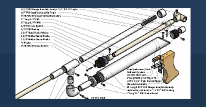This is a seven string Anglo Saxon lyre I just finished, tuned in E flat diatonic. The body frame is maple, the soundboard is birch, and the saddle and tailpiece are mahogany. The bridge is poplar. Traditional bridges are carved, but I decided to take the quicker route, and made it out of dowels. The finish is linseed oil.
A closeup of the tailpiece, tied on with artificial sinew. The strings are a leftover set from an oud. I won’t use a wound low string again, as it doesn’t ring very well when it’s at a tension high enough to keep the unwound strings from being flabby. Unwound classical guitar strings have worked quite well.
What I find interesting about these instruments is that they typically weren’t plucked like a harp, but strummed. The left hand mutes the strings that shouldn’t sound, like an autoharp. Also surprising is that these lyres get an awful lot of sound out of a soundbox that's only .75" deep, not to mention no soundholes.















